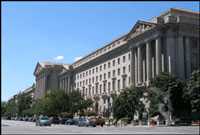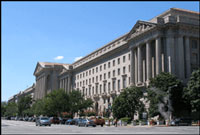
The Green Build-out Begins
More contractors see the benefit of being eco-friendly, for customers and for themselves
- By David Hubler
- Apr 30, 2009
 Spurred by the Obama administration's call to reduce the country's dependence on foreign oil by adopting alternative energy sources and increasing energy efficiency, green is rapidly becoming the color of choice across all facets of the federal contracting community.
Spurred by the Obama administration's call to reduce the country's dependence on foreign oil by adopting alternative energy sources and increasing energy efficiency, green is rapidly becoming the color of choice across all facets of the federal contracting community.
The American Recovery and Reinvestment Act of 2009 includes $4.5 billion for the General Services Administration to make federal buildings more energy efficient and $4.5 billion for the Department of Energy to develop smart-grid technologies for the energy infrastructure.
"Only a few federal agencies truly focused on energy efficiency in the past," said Bill Prindle, vice president of the energy, climate, and transportation practice at ICF International Inc., a provider of carbon mitigation and climate change adaptation services to companies and governments. The U.S. Environmental Protection Agency traditionally has been among the most active, he added.
"Now there's a rather dramatic widening of the playing field as more and more agencies are being given directives or other inducements to green up their buildings and measure their carbon footprints and so forth," Prindle said.
Green on the inside
Government contractors are also realizing the importance of going green in their own facilities.
ICF made a commitment in 2008 to become carbon neutral. In announcing that strategy, company officials said it would help with employee recruitment, morale, and retention; build brand awareness; and underscore their commitment to being a responsible company.
Because ICF is also in the business of advising companies and government agencies on environmental issues, the move shows that the company practices what it preaches, officials said.
QinetiQ North America also has internal benefits in mind as it prepares to transfer about 400 employees into a new eight-story, 200,000-square-foot facility in Reston, Va., that will house many of the company's government software developers.
The building was designed and constructed to accommodate current and future advances in green technology, said Randy Jackson, who oversees the company's insurance and real estate leasing as vice president of risk management.
Duane Andrews, QinetiQ North America's chief executive officer, said companies that want to attract and retain high quality people must be aware that talented workers want more than just a building in which to work.
"There is an entire generation of prospective employees that grew up recycling and using environmentally friendly products," Andrews said. "They're socially aware, and their employer of choice will have to share that value. Part of our responsibility as a large company is to be socially responsible."
Everyone involved in the project has been vigilant in choosing materials and amenities that will make the building as green as possible, Andrews said, adding that the savings in energy consumption is enough to make a good business case for the move.
"When you combine the savings with social responsibility and environmental stewardship, it's a slam dunk," he said.
The green business case
The QinetiQ building will use virtualization software, blade servers, and other green technology to significantly reduce heating and cooling and lower the company's utility bills, said Dave Riggs, senior vice president of federal solutions at the company's Missions Solutions Group.
| Green government initiatives
The economic stimulus package includes funding for the following green initiatives.
- $4.5 billion for the General Services Administration to make federal buildings more energy efficient.
- $4 billion for Defense Department operations and maintenance, including efforts to improve energy efficiency.
- $3 billion for the Housing and Urban Development Department to improve the energy efficiency of public housing.
- $4.5 billion for the Energy Department to develop smart grid technologies for the energy infrastructure.
- $500 million for the Labor Department to fund training and education related to energy efficiency and renewable energy.
Sources: H.R. 1 and Senate Report 111-3 |
"That can save you up to 65 [percent] to 70 percent on your power consumption and on your air conditioning," he said. "Initially, we're going to get a big bang for our buck by using green technology in the building elements but also in the technology that we utilize to do our business."
He said an internal analysis concluded that a virtualized environment would reduce carbon emissions by 66 percent and needed work space by 68 percent.
"There will probably be less square footage devoted to private offices and more space devoted to teaming areas," Riggs said.
The building was constructed on an east/west axis to take advantage of a full day's sunlight and further reduce electricity consumption, said Vicki Davis, executive assistant to the president of the Technology Solutions Group, whose 75 employees will move to the building this fall.
"There's no natural light for any of our [current] conference rooms, for any of our public spaces," said Davis, whose current office has no window. "It's kind of a fresh start for us."
She said recycled air in the server rooms and energy-efficient kitchen appliances will also reduce power consumption. In addition, a reverse osmosis filtration system will supply drinking water and eliminate the need to buy bottled water and recycle the empty bottles.
Expert advice needed
Experts say that although government contractors are adept at information technology, when it comes to the complexity of green technology, it's advisable to bring in outside specialists.
Davis, Jackson, and Riggs were members of a preconstruction advisory group that worked with Jones Lang LaSalle, a global real estate services company, and Fox Architects, of McLean, Va., to design the new space.
Both firms have professionals who can guide and track QinetiQ's accumulation of credits toward its eventual Leadership in Energy and Environmental Design (LEED) certification from the http://www.usgbc.org/ U.S. Green Building Council, Jackson said.
"What QinetiQ is doing is being highly responsible," said Jim Allegro, a LEED-accredited professional and principal at Fox Architects. He said QinetiQ is doing everything it can to incorporate green principles into the design.
Carpeting will include about 25 percent recycled fibers, and the woodwork veneer was engineered from common, rapidly renewable woods such as poplar, Allegro said. "If we can make poplar look like teak in this case, then we're preserving the environment," he said.
QinetiQ's space will have energy-efficient fluorescent and LED fixtures, occupancy sensors to control lighting, and task lighting at each workstation to help provide the correct illumination for each employee. "It's one of the very green things that the U.S. Green [Building] Council promotes," Allegro said.
"Everything we do nowadays, if it's glued or adhered or painted, we try to use materials that are low in … volatile organic compounds," Allegro said. Those compounds have been known to make workers ill and create unhealthy buildings that could become uninhabitable.
Because of the complexities of green technology, hiring experts was the smart way to go, Prindle said. "I like to say it's not rocket science — it's harder than rocket science. It's like dealing with a bunch of rockets designed by different people flying around inside a building that wasn't really thought of as a firing range for any of them," he said.
However, the most reliable green yardstick is a building's energy performance because "it's the most measurable," he added.
Peak performance
Energy performance is a crucial aspect in the design of EDS Corp.'s ECO-2 under construction near Billingham in northeastern England. It is one of Europe's most environmentally friendly data centers.
EDS officials said they expect a 47 percent reduction in lighting costs and a 40 percent annual energy savings compared to conventional data centers. The facility uses the cool coastal air from the North Sea to lower the temperatures of ECO-2's IT equipment and plant space.
Hewlett-Packard, EDS' parent company, has been designing energy-saving technology for 20 years, including a wide range of green products for the federal government, said John Frey, Americas sustainability executive at HP.
The company is working with various U.S. government agencies to reduce their carbon footprints and make their data centers more energy efficient through innovations such as virtualization and blade server technologies that lower heating and cooling requirements, he said.
"That's where a lot of technology [innovation] is going," Frey said.
"A little over 50 percent of the energy that you put into the average data center is used to cool it back down from the heat generated by the hardware," he said.
Although blade servers — self-contained computer units that take up minimal physical space — might increase power consumption because a number of them can reside in a small space, their corresponding heat output is lower than conventional rackmount servers.
Government agencies might pay a slightly higher price for products that meet the Green Electronics Council's Electronic Product Environmental Assessment Tool (EPEAT) gold standard because the power supply efficiency requirements tend to drive up the cost, Frey said. But as hardware vendors produce more EPEAT products, "that cost differential drops to zero and then becomes the norm," he said.
In addition, HP is developing a telepresence technology called Halo that creates instant face-to-face communications worldwide, thereby reducing energy consumption by eliminating the need to travel to meetings, Frey said.
"The cool thing for government agencies is we own all the backbone lines, and it's encrypted," Frey said. "It's for agencies that need to have a telepresence solution but with a higher degree of security than [through] commercially available lines."
"We've had some internal green initiatives to make our products more efficient in the consumption of power and heat," said Brad Boston, senior vice president of global government solutions and corporate security programs at Cisco Systems Inc. "That's been a major issue for our R&D folks over the last couple of years."
In March, Cisco entered the server market when it unveiled its Unified Computing System, which fuses computing, network, storage access and virtualization resources into a single energy-efficient system.
The Unified Computing System uses one-half the components and requires less cabling and fewer power and cooling resources than existing server installations, Cisco officials said.
Boston called the system a major green advancement because its use of virtualization means "you will be able to do the same kind of workloads with a much more efficient consumption of power and [less] generation of heat."
Reducing power demands in data centers is a critical component of Dell Inc.'s marketing of green technology to the federal sector, said Albert Esser, vice president of Dell's Data Center Infrastructure group. "I interact with the public sector more so than I would say in the past," said Esser, whose technical expertise is power and cooling technology solutions. Leaders at the highest levels of government are talking to Dell about green data centers, he added.
Although virtualization is still underused, its potential is enormous, he said. For example, 25 percent of the servers in a typical data center handle about 80 percent of the applications. But if the remaining 20 percent of applications were shifted to those servers through technologies such as virtualization, "you could turn off three-quarters of your data center — not just a couple percent, but three-quarters," Esser said. "And that is basically cutting your carbon footprint by three-quarters."
About the Author
David Hubler is associate editor of Washington Technology, an 1105 Media, Inc. publication. This article first appeared in the magazine in April 2009.